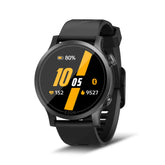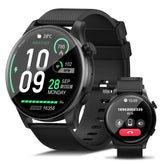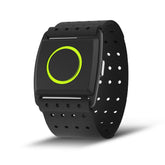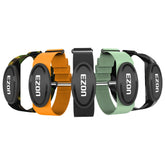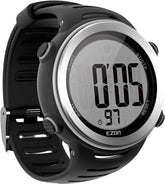The Ultimate Guide to Heart Rate Monitoring in Sports: Chest Straps vs Armbands
Choosing the right heart rate monitor can elevate your training precision, whether you’re a competitive athlete or a fitness enthusiast. This in-depth comparison breaks down the key differences between chest strap heart rate monitors (e.g., EZON C009Pro) and heart rate monitor armbands (e.g., EZON C022Pro), covering accuracy, comfort, and suitability for different sports. Discover which option aligns with your workout needs and performance goals.
1. Core Technology: How They Track Heart Rate
A. Chest Strap Monitors: Electrical Conductivity at Work
-
Mechanism:
- Chest straps like the EZON C009Pro use electrodes to measure the electrical signals of heartbeats as they travel through sweat on the skin.
- Data is transmitted via ANT+ or Bluetooth to watches, apps, or bikes.
-
Accuracy:
- Error margin: ±1–2 BPM, even during high-intensity movements (Journal of Sports Medicine).
- Ideal for activities with repetitive motion (running, cycling) where chest movement is consistent.
B. Armband Monitors: Optical Sensors for Motion Resilience
-
Mechanism:
- Armbands such as the EZON C022Pro use photoplethysmography (PPG), shining LEDs into the skin to detect blood volume changes in vessels.
- Placed on the forearm, they avoid bone density interference (common in wrist-worn devices).
-
Accuracy:
- Error margin: ±2–3 BPM, improved by dual-wavelength sensors (green + infrared) to reduce motion artifact.
- Excels in sports with varied arm movements (swimming, weightlifting).
2. Comfort & Usability: Wearability Matters
Chest Strap Pros & Cons
-
Pros:
- Minimal Lag: Direct electrical signals mean zero delay in heart rate updates.
- Lightweight Design: Most weigh <50g, including the EZON C009Pro (38g), with adjustable straps for all body types.
-
Cons:
- Chafing Risk: Prolonged use or improper sizing can cause skin irritation, especially during sweaty workouts.
- Setup Fuss: Requires moistening the electrodes before use for optimal conductivity.
Armband Pros & Cons
-
Pros:
- No Chest Compression: Ideal for users who find chest straps restrictive, like runners with larger chests.
- Secure Fit: Elastic armbands (e.g., EZON C022Pro) stay in place during high-impact activities without constricting breathing.
-
Cons:
- Sensitivity to Placement: Must be worn 3–4cm above the elbow for consistent readings; loose fit leads to data drift.
- Battery Dependency: Optical sensors consume more power, typically requiring charging every 10–15 hours.
3. Sport-Specific Performance: When to Choose Which
A. Chest Straps Shine in These Scenarios
-
High-Intensity Interval Training (HIIT):
- The EZON C009Pro’s instant data feedback is critical for maintaining target heart rate zones during quick interval transitions.
-
Cycling & Triathlons:
- Works seamlessly with bike computers and triathlon watches, transmitting data to handlebar displays without signal loss.
-
Lab-Grade Testing:
- Preferred in research settings for its medical-grade accuracy, making it ideal for athletes needing precise heart rate monitor analysis.
B. Armbands Excel in These Scenarios
-
Swimming & Water Sports:
- The EZON C022Pro’s 10ATM water resistance and arm placement avoid water interference, unlike chest straps that may lose contact when wet.
-
Weightlifting & Strength Training:
- No chest strap to interfere with barbell movements; the armband stays stable during compound lifts like bench presses.
-
Everyday Fitness & Recovery:
- Comfortable for all-day wear to monitor resting heart rate and sleep, a feature lacking in most chest straps.
4. Key Feature Comparison Table
| Feature | Chest Strap (EZON C009Pro) | Armband (EZON C022Pro) |
|---|---|---|
| Sensor Type | Electrical electrodes | Optical PPG (dual LED) |
| Accuracy (BPM) | ±1–2 | ±2–3 (excellent for arms) |
| Water Resistance | 5ATM (suitable for pool) | 10ATM (open water safe) |
| Battery Life | 6–12 months (coin cell) | 12–15 hours (USB-C charging) |
| Connectivity | ANT+/Bluetooth | Bluetooth 5.0 |
| Ideal Users | High-intensity athletes | Multi-sport, comfort-focused users |
| Price | $49.99 | $59.99 |
5. User Tips for Optimal Performance
For Chest Strap Users
- Proper Fit: Adjust the strap so it sits just below the sternum, tight enough to stay put but not restrict breathing.
- Skin Preparation: Use hypoallergenic gel (not water) on electrodes for long workouts to prevent drying and signal loss.
For Armband Users
- Placement Guide: Position the sensor 3–4cm above the elbow crease, ensuring the armband is snug but not cutting off circulation.
- Cleaning Routine: Wipe the sensor lens after workouts to remove sweat residue, which can degrade optical accuracy.
6. Common Myths Debunked
Myth 1: Chest Straps Are Only for Serious Athletes
- Fact: While popular in pro sports, chest strap heart rate monitors are great for anyone prioritizing accuracy, from beginners tracking calorie burn to runners optimizing pace.
Myth 2: Armbands Can’t Keep Up with Fast Movements
- Fact: Modern armbands like the EZON C022Pro use advanced accelerometers to filter motion noise, making them reliable for CrossFit, boxing, and other dynamic sports.
Myth 3: Chest Straps Are Uncomfortable for Women
- Fact: Adjustable straps and moisture-wicking fabrics (like the EZON C009Pro’s hypoallergenic material) make them comfortable for all genders when sized correctly.
7. Which Should You Choose? A Decision Guide
-
Choose Chest Strap If:
- You need lab-level accuracy for interval training or race pacing.
- You primarily do endurance sports (running, cycling, rowing).
- You dislike charging wearable devices frequently (coin-cell battery lasts months).
-
Choose Armband If:
- You do water sports, strength training, or mixed martial arts.
- Chest straps cause discomfort or chafing.
- You want a versatile device for both workouts and 24/7 health tracking.
8. FAQs: Heart Rate Monitor Basics
Q: Can I use a chest strap with a smartwatch?
- Yes—most modern watches (including EZON’s sports series) pair with chest straps via Bluetooth for enhanced accuracy.
Q: Do armbands work for people with dark skin?
- Yes. Dual-wavelength PPG sensors in the EZON C022Pro adapt to various skin tones, unlike single-LED wrist trackers that may struggle.
Q: How often should I replace a chest strap battery?
- Most last 6–12 months with daily use. Replace when connectivity issues or delayed data transmission occur.
Final Verdict: Precision Meets Practicality
Both chest straps and armbands have distinct advantages, depending on your sport, comfort preferences, and accuracy needs. The EZON C009Pro chest strap is a powerhouse for precision and endurance, while the EZON C022Pro armband offers versatility and comfort for dynamic workouts and everyday use.
Ultimately, the best heart rate monitor is the one you’ll wear consistently. Whether chasing PRs on the track or perfecting your swim stroke, let technology work with you—not against you—to unlock your full athletic potential.
https://ezonwatch.com
